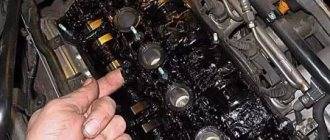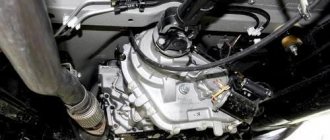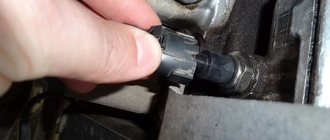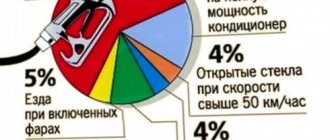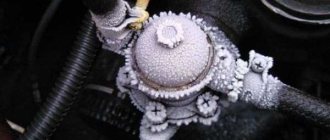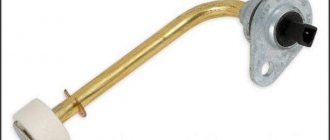Question from a reader:
«Hello. Please tell me what is the normal oil consumption for a not new engine. The foreign car has a mileage of about 180,000 kilometers. Every thousand I add almost 300 grams! I don't think this is normal? Thanks in advance for your answer
»
To be honest, I have already talked a little about oil consumption. BUT today I want to talk about normal value. An internal combustion engine, no matter how ideal it is, still consumes a little oil - so what is the normal value……..
Conventionally, I want to divide the engines: - these are regular gasoline, turbocharged gasoline and diesel, as a rule, they are also turbocharged.
One golden rule
is that
normal fuel consumption is calculated not by the mileage of the car, but by the fuel consumption. That is, per 100 or 1000 liters consumed. Usually a value equal to 100 liters is taken.
Regular gasoline engine
For new gasoline engines, normal oil consumption is considered to be 0.005 - 0.025% per 100 liters. That is, with an average mileage of 1000 kilometers, normal oil consumption will be 5 - 25 grams.
For normally worn engines, normal oil consumption is 0.025 - 0.1%, that is, per 1000 km you will need to fill in 25 - 100 grams of engine oil.
For worn-out engines on the verge of repair - oil consumption is 0.4 - 0.6% per 100 liters of fuel. This is 400 - 600 grams per 100 liters. The critical level is 0.8% - 800 grams of oil per 100 liters.
Turbocharged engines have a slightly higher normal oil consumption than conventional naturally aspirated engines.
For a new engine, normal consumption may well be 80 grams per 100 liters. That is, for 1000 kilometers we add 80 grams, 10,000 km - already about 800 grams
For worn-out turbocharged engines, here guys it can go up to two liters. And if the turbine is faulty, then the consumption may be even higher. Therefore, if your car consumes more than two liters, then it needs to be diagnosed and repaired if necessary.
The consumption of a diesel engine is almost the same as a turbocharged engine. Normal oil consumption is about 300 - 500 grams of oil per 10,000 kilometers. If the consumption exceeds 2 liters, then you need to go to the service center.
That's all. Your 300 grams per 1000 kilometers is definitely a lot, go to a car service for now.
In the section on the question Where can I find standards and what is the frequency for replacing antifreeze? set by the author Ђaisia Lukanina
the best answer is: To minimize the risk of engine overheating, you need to carefully monitor the serviceability of all elements of the cooling system, carry out preventive maintenance and technical inspection, maintain the required level of coolant and promptly eliminate its leaks. Antifreeze should be replaced every two years or every 50 thousand kilometers. When replacing antifreeze, it is advisable to clean the cooling system of rust, scale and other contaminants using special cleaning products.
Reply from Jurela
[guru] The main thing... is that he is not a leftist!! ! Before the winter period... check... Well, that’s it, in principle, it depends on the mechanic or drivers! ! Why are they... straight... like columns!!!
Reply from Yuriy
[newbie] Try reading the operating instructions or service book, it seems like everything should be written there.
Answer from ETERNAL STUDENT 2007
[master] for passenger cars there are manufacturers' recommendations - replacement every 3 years. I think no more for trucks either, because on average, after 3 years, antifreeze loses most of its useful properties. . on the page find the Appendix to the order of the Ministry of Transport of Russia dated March 14, 2008 N AM-23-r METHODOLOGICAL RECOMMENDATIONS FOR CONSUMPTION RATES OF FUELS AND LUBRICANTS IN ROAD TRANSPORT
Reply from AVL
[guru] The norm of life is once every 3 years.
Answer from Alexey Baranov
[guru] Some antifreezes can withstand 5 years of operation and 100–250 thousand kilometers. The shelf life and frequency of fluid replacement are usually indicated on the packaging. And yet, during operation, coolants gradually lose their properties: due to the activation of additives and a decrease in the alkalinity reserve, aggressiveness towards rubber and metals increases, and foaming increases.
Engine oil consumption
is determined depending on the amount that burns out in the engine. may indicate either poor quality (the lubricant then burns out excessively), or a malfunction of the engine itself (leakage occurs, most often through valve seals and oil rings). Everything will depend on the specific numbers and additional symptoms that may appear when the lubricating fluid is lost.
How is engine oil consumption calculated?
To determine the norm, it is not the mileage value that is taken into account, but the fuel consumption. This indicator is more accurate than the distance traveled, because when you are stuck in traffic jams, the oil is depleted even more, and the odometer does not change its value.
Engine oil consumption is usually calculated based on the volume spent on burning 100 liters of fuel.
To find out the oil consumption rate in your car's engine, you need to use a calculation formula and a calculator, or use this online form. It involves calculating the permissible amount of oil for waste according to the type of engine, the volume of operating oil and the amount of fuel consumed, taking into account the condition of the piston group.
Calculation formulas for oil consumption
Total actual oil consumption for waste during its operating cycle
(from replacement to replacement) can be calculated using the formula:
Qy = ∑q + (Qз-Qсл),
Where ∑q is the oil added during the cycle (between maintenance); Qз - filled during refueling; Qsl – drained during replacement.
But the consumption of filled oil in liters per 100 liters of fuel
defined like this:
Mз = V / (P*k),
Where V is the capacity of the engine lubrication system; P – consumed fuel k – coefficient taking into account wear of the piston group (k – for a diesel car 1.25; petrol 1.15; turbo 1.3).
Oil consumption rates increase to 20% for vehicles after major repairs and in operation for more than 5 years.
What engine oil consumption is considered normal?
First of all, it must be said that all engines, by their design, consume lubricant in varying amounts. This process directly depends on the design of the engine itself and its main components. In other words, loss occurs during the process of supplying lubricant to the surface of the cylinders. This section of the engine is the most heat-exposed and it is here that evaporation and combustion of a certain volume occurs.
Consumption depends on engine type:
- Gasoline engines that have been produced over the past 10-15 years. should consume 0.005-0.025% per 100 liters of fuel. Based on this, per 100 km. from 5 to 25 ml should be spent.
- Gasoline engines with severe wear consume 0.4-0.6% per 100 liters of fuel. At 100 km. way, the engine consumes 0.4-0.6 liters. In some cases, consumption can reach up to 0.8% (0.8 liters per 100 liters).
- Turbine engines consume more than gasoline engines. So new power units should consume 0.08 liters. per 100 l. fuel. So for 1000 km. the engine consumes 0.08 liters. oil, and at 10,000 km. respectively 0.8 l. Worn out turbo engines can consume up to 2 liters. per 1000 km.
Diesel engines consume engine oil almost at the level of turbo engines. Normal consumption for a diesel engine is 0.3-0.5 liters. per 1000 km. Many motorists claim that consumption depends on the technical condition of the engine and its operating conditions.
Engine oil consumption rate for waste
For passenger cars
transport, the normal indicator of waste is a consumption of 0.005 - 0.025% per 100 liters of fuel, which is approximately from 5 to 25 grams of oil per 1 thousand km. In a worn engine it can reach up to 0.1% and 100 g. per 1000 km respectively. Well, if the car operates at the limit or has a turbocharged or diesel unit, then this norm will be even higher.
For freight
for long lengths, the oil consumption rate is 0.3 - 0.4% of fuel consumption. The calculation formula uses the amount of fuel burned and oil added during this period. But this calculation of oil consumption, proposed by the automaker Scania, is relevant only for heavy cars with a large engine. Calculations of lubricant consumption in passenger cars, both with diesel and gasoline engines, have a slightly different form.
Engine oil consumption rate per 100 liters. fuel for passenger cars
For carburetor VAZ cars, the norm is considered to be a consumption of 0.3 to 0.4 liters. per 100 liters of fuel.
A gasoline engine operating at the limit of its capabilities can consume from 0.4 to 0.6% at 100 hp. fuel consumed, which is approximately 400 - 600 grams of engine oil per 1000 km. The situation is exactly the same with diesel engines - engine lubricant consumption increases by 0.5%. But if these are forced turbodiesels with two turbines, then the consumption can reach up to 3% of the volume of oil poured into the engine.
Please keep in mind that oil consumption rates
significantly increase for cars after major repairs and in operation
for more than five years
.
The average amount of engine oil consumed by an engine after a run of 150 thousand km is 0.35 - 0.55 liters.
Method for determining oil consumption
Oil level on dipstick
Determination of the actual value of specific engine oil consumption for waste is carried out over a mileage of 200-300 km. The vehicle must be technically sound during the test drive. The oil level in the crankcase should be between the “MAX” and “MIN” marks on the engine dipstick. Before the test run, it is necessary to warm up the engine, the oil temperature should be 80-85°C. Drain the oil on a level surface. It should drain from the pan within 15 minutes. For the accuracy of the result, it is advisable to determine not the volume, but rather the weight, since the amount of lubricant remaining in the filter can only be determined by weighing it.
Lubricant consumption is within normal limits
Any engine consumes engine mixture; it burns out in the cylinder-piston group or in the combustion chamber along with the fuel. The normal consumption of motor oil for gasoline power units is from 0.005% to 0.6% of 100 liters consumed. For diesel engines, the normal consumption is from 0.03% to 3%. Keep in mind that the oil consumption rate for each engine is different, depending on its technical design and service life. Engine mixture consumption can increase up to 20% if the car has been in use for more than five years, or after a major overhaul of the unit.
An increase in engine oil consumption can be caused by many reasons, some of which can be eliminated on your own. In this case, the motorist must adhere to the following rules:
- Always measure the engine mixture level before driving.
- Please note: it is considered critical for gasoline units to add more than 600 g of oil. for 1 thousand km, for diesel engines you need to look for the cause of the breakdown if more than 300 g is consumed. per 1 thousand km.
- The rate of consumption of motor fluid must be calculated without taking into account the mileage of the car: the amount of mixture used for topping up is taken per 100 liters consumed.
You can look at the oil consumption rate in the engine in the documentation for the car. If this is not possible, then consult a service station or contact a car dealer and clarify the information you are interested in.
Watch the video that shows the reasons for engine oil consumption:
How to use the calculator
One of the main roles in this calculation is played by the volume of fuel burned and the volume of operating oil, as well as the type of engine. It is in relation to this volume and specifics of work that the specific oil consumption is calculated.
To calculate specific engine oil consumption, the following data is required:
- In the “fuel” field, enter the average fuel consumption in liters per 1`000 km. mileage (by default and based on calculation formulas this is 100 liters);
- In the “oil” field - the volume of oil that is regulated by the manufacturer as necessary when filling;
- Select the engine type and check if the machine has been in use for more than 5 years
- Click "calculate".
Please note that the results of the calculator for calculating the permissible engine oil consumption rate are a general case and for some engines (due to the specific design) may be inaccurate and need to be adjusted.
Such a calculation calculator can be an indispensable assistant for calculating the consumption rate of lubricants intended for operational accounting of the specific consumption of motor oil when justifying the need for them. After all, if not all, then many car enthusiasts have a rather wary attitude towards engine oil consumption. This service will show whether you are within the nominal values. If not, then you will have an objective reason to look for reasons and possible problems.
What's the outcome
That is, if the engine is in order, then it takes practically no oil, and you will not need to top it up until the next change. Its level will be within acceptable limits on the dipstick (within the min./max. marks). But there are cases when the manufacturer indicates consumption rates for a specific power unit (some), then topping it up is considered natural and is not a malfunction, but on average it does not exceed 1-2 glasses from replacement to replacement.
It is important to understand that the harder the engine runs, the more oil it burns. For example, the higher the number of revolutions, the more oil will remain in the cylinders of the car engine. Although we should not forget not only about the operating mode of the engine, but also its design. You should also not neglect the tolerances of motor oils and fill in fuels and lubricants of dubious quality.
Every car enthusiast knows for sure that for normal operation of the engine in his car, it is necessary to maintain the required level of lubrication. During operation, oil is naturally consumed and needs to be topped up. The question arises, what is considered normal engine oil consumption?
This article will discuss exactly this; the reasons for lubricant consumption for the most common engines will be described, and recommendations will also be given for proper control of lubrication in the engine.
Factors influencing increased oil consumption
Increased lubricant consumption is a wake-up call for any car owner. As a rule, high engine oil consumption is present in cars with high mileage. This indicator must be monitored periodically, because a lack of oil can cause expensive repairs.
The oil consumption rate consists of a combination of the following factors:
- Age of the motor and its technical characteristics. This also includes timely maintenance, weather conditions under which it was operated, etc.;
- Engine type. Normal oil consumption for gasoline, diesel and turbocharged engines varies significantly and this aspect must be taken into account;
- The quality indicators of the lubricant itself play a huge role. Oil viscosity is one of the main criteria for assessing consumption.
It is worth noting that an excess amount of fuel and lubricants in the engine also increases its consumption. A normalized lubricant level can prevent expensive repairs and save you from unnecessary expenses.
The vehicle can be operated under different conditions (for example, frequent stoppages in traffic jams or, conversely, driving on country roads), which affect the correctness of the consumption information. A generally accepted indicator for measuring engine oil consumption is the ratio of the amount of lubricant consumed per 100 liters of fuel.
What engine oil consumption is considered normal?
It is necessary to determine the rate of oil consumption by the volume spent per hundred liters of fuel. Running in a new engine up to five thousand kilometers ensures oil consumption of up to 1 l/1000 km on average. A similar amount will be consumed when changing piston rings.
Lubricant consumption limits for a mileage from five to one hundred and fifty thousand kilometers in l/1000 km:
- standard operating mode – 0.25;
- high-speed, characterized by an increase in the load on the vehicle – 0.4;
- driving along mountain serpentine roads and on similar routes – 0.5.
If the mileage is more than one hundred and fifty thousand, the normal figure will change and will be from 0.35 to 0.55 l/1000 km due to wear of parts.
Indicators of normal oil consumption for different types of engines
As described earlier, it is worth paying special attention to the type of engine in your car. Oil consumption for different engines directly depends on their design. Below are the normal consumption figures for each type of motor.
Gasoline power unit
For vehicles recently released from the production line, normal oil consumption is considered to be not more than 2.5 ml/100 liters of fuel. It is worth noting that when running in a new car, this figure can be significantly higher, since the new parts have not yet completely gotten used to each other.
The permissible value for used cars is 100 g per 100 liters of fuel. This oil consumption is typical for cars with low mileage and in good technical condition.
Increased oil consumption of about 0.5 liters per 100 liters of fuel is considered critical. At this level of lubricant consumption or higher, the engine may simply jam on the move, so at such indicators it is recommended to visit the nearest technical inspection point.
Diesel power unit
Normal fuel consumption for diesel engines is around 300-500 g/100 l. The critical consumption indicator for this type of motor is a consumption equal to 2000 g/100 l. In a diesel engine, there is constantly high pressure, which affects oil costs. Very often, diesel engines are used in construction equipment and trucks that constantly transport heavy loads. All this additional power consumption also increases lubricant consumption significantly.
Turbocharged power unit
It is worth saying that recently more and more new engines with turbines have been appearing. There are both gasoline power units with a turbine and modern turbodiesels on the market. The number of turbines can also reach 3 on one engine.
These power units have enormous power in a completely small size. It follows that oil consumption directly depends on engine power, so these units are subject to the greatest waste of lubricant.
Even a new turbocharged engine consumes about 80 g of oil per 1000 liters. For full operation of the turbine itself, lubrication is required, and if there are several turbines, then the fuel costs will be much more significant.
And so, an oil consumption rate of 1 liter per 1000 km or 100 liters of fuel for a conventional engine is a critical norm, and for 2 other types of engines the critical indicator will be 2 liters / 1000 km or 100 liters of fuel.
The reasons for excessive oil consumption may be a dirty oil filter; its condition must also be monitored and a new one must be installed during a routine oil change.
Why does over-consumption of lubricant occur?
The oil inside a car engine can be consumed either naturally or for a number of the following reasons:
- A banal transfer of oil into the engine. The increased volume of lubricant causes the oil to push itself through the holes inside the engine. The oil simply evaporates through the ventilation system to the outside and requires further topping up;
- Purchasing the cheapest lubricant. Low-quality oil has minimal viscosity and evaporates more quickly compared to more expensive analogues;
- Excessive loads on the power unit. An overly active driving style increases oil consumption; this indicator can also be influenced by the terrain itself (mountainous, flat, etc.);
- Ambient temperature. The increase in temperature is directly proportional to the increase in lubricant consumption;
- Physical losses. They are usually associated with a malfunction of the oil filter, but can be caused by a leak in the engine itself. Very often the gasket between the cylinder head and the engine body fails, and the bolts can also simply loosen.
Don’t forget that a regular oil change should be done at least once every 10,000 km. Such recommendations are usually given by the car manufacturer, but in reality it is better to change the oil much more often. It is believed that no more than 8 thousand km should pass from replacement to replacement, and for cars with increased power this procedure is recommended to be carried out every 5 thousand km.
In used vehicles, you can additionally use various additives that help reduce lubricant consumption. On the modern automobile market there are many engines that, due to their design features, begin to “eat” oil already in the first year of operation.
The operation of which engine components and parts affects increased lubricant consumption?
The liquid inside the engine may leak out or evaporate. As a rule, evaporation occurs on the surface of overheated parts and mechanisms. Next, we will describe the main signs of incorrect operation of engine parts, which can affect the oil consumption:
- Main cylinder block. Often the gasket between the block and the cylinder head begins to leak. The problem can be identified visually;
- Crankshaft . Similar to the case described above, oil seals may leak due to severe wear. You can find the problem by disassembling the motor. In this case, the seals will have to be replaced with new ones;
- Oil filter. It may become clogged or simply not screwed on properly. The problem is easy to identify visually and replace this unit with a new one;
- Gas distribution valves. Oil seals may fail due to overheating. Oil will begin to seep into the timing mechanism. The problem is eliminated by replacing the rubber caps;
- Oil scraper rings. Wear of these rings located on the pistons is a very common problem. Blueish smoke from oil fumes begins to come out of the exhaust pipe. The situation can be corrected by replacing the rings;
- Cylinder failure. Often, under the influence of high temperatures, scuffing and excessive wear are formed in them. Oil is literally absorbed into these microcracks, causing excessive lubricant consumption. The problem can sometimes be solved by replacing the piston and oil rings, but it may also require boring or grinding the cylinders themselves;
- Turbine lubrication. The turbocharger constantly pumps air, which causes it to constantly heat up. It also needs lubrication during operation. The sizes of turbines can be very different, so you need to take into account the total volume of oil poured into the engine.
Conclusion
This text highlighted the most significant points regarding normal oil consumption in motor vehicles. The normal consumption that each type of engine should have was described, and the reasons why these excess expenses occur were described.
You should constantly monitor the level of lubricant in your car’s engine. Neither its shortage nor its excess should be allowed in equal measure. In any case, before you start using the vehicle, you should carefully study the instructions for its operation. It is also worth using fuels and lubricants recommended by the car manufacturer. In this case, the risks will be minimized.
It should be remembered that oil consumption in vehicles with decent mileage is always much higher, therefore, if the lubricant costs more than 500 grams per 100 liters of gasoline or a thousand kilometers, you should contact a service center and conduct a thorough check of the entire engine.
The problem of engine oil consumption worries many car enthusiasts. As you know, lubricant consumption is one of the important indicators of the overall condition of the engine. You can hear from some car owners that the engine does not take oil, that is, the level remains the same or remains within acceptable limits from replacement to replacement.
Others note increased or high oil consumption in the engine, which causes the need. Let us immediately note that the manufacturers themselves separately indicate the oil consumption rates in the engine. This means that the power unit can consume lubricant within certain limits, and such consumption is not a malfunction.
This phenomenon is usually called oil consumption due to waste. However, exceeding the norm for adding oil to the engine may well indicate problems with the internal combustion engine, engine, etc.
In this article we will look at what kind of “oil appetite” of various power units can be considered acceptable, as well as what factors and features affect lubricant consumption in internal combustion engines.
Read in this article
So, let's start with the fact that all engines consume motor oil to a greater or lesser extent. This happens taking into account the design features of the internal combustion engine, namely due to the urgent need to lubricate components and parts. In other words, the main loss of lubricant occurs as a result of the need to supply lubricant to the cylinder walls.
This area in the engine is a heat-loaded area. For this reason, partial evaporation and combustion of the lubricant occurs. Also, some of the oil is not removed from the cylinder walls, as a result of which the remaining lubricant burns along with the fuel in the combustion chamber.
As a rule, in modern engines the declared oil consumption is, on average, from 0.1 to 0.3% of the total fuel consumption that was spent to overcome any part of the journey. It turns out that if the car has traveled 100 km, and the consumption is 10 liters of fuel, then the norm will also be to consume, on average, 20 grams of oil.
It turns out that lubricant consumption can be considered acceptable if it does not exceed about 3 liters. per 10 thousand kilometers traveled. It is also important to understand that the consumption rate will greatly depend on the type of engine, its degree, etc.
For example, for many gasoline internal combustion engines, the norm is around 0.1%. On gasoline turbo engines, the consumption rate is noticeably higher. As for the standard, the declared lubricant consumption will be greater than any gasoline analogue and ranges, on average, from 0.8 to 3%. The indicated 3% is consumed by forced turbodiesels with two turbines, etc.
You can also separately mention rotary motors, which are particularly prone to lubricant consumption. Such units (taking into account their fully operational condition) consume about 1-1.2 liters of oil per 1000 km. mileage For reference, the manuals for different engines indicate that the norm for oil consumption for waste is 1 liter per 3 thousand km traveled, that is, about 3 liters per 10 thousand km.
At the same time, manufacturers also note that consumption directly depends on both the technical condition of the internal combustion engine and the operating characteristics of a particular vehicle (load on the unit, speed, etc.)
Engine oil consumption in the engine is normal
So, let's start with the fact that all engines consume motor oil to a greater or lesser extent. This occurs taking into account the design features of the internal combustion engine, namely due to the urgent need to lubricate the components and parts of the CPG. In other words, the main loss of lubricant occurs as a result of the need to supply lubricant to the cylinder walls.
This area in the engine is a heat-loaded area. For this reason, partial evaporation and combustion of the lubricant occurs. Also, some of the oil is not removed from the cylinder walls by the piston rings, as a result of which the remaining lubricant burns along with the fuel in the combustion chamber.
As a rule, in modern engines the declared oil consumption is, on average, from 0.1 to 0.3% of the total fuel consumption that was spent to overcome any part of the journey. It turns out that if the car has traveled 100 km, and the consumption is 10 liters of fuel, then the norm will also be to consume, on average, 20 grams of oil.
It turns out that lubricant consumption can be considered acceptable if it does not exceed about 3 liters. per 10 thousand kilometers traveled. It is also important to understand that the consumption rate will greatly depend on the type of engine, the degree of its boost, etc.
For example, for many gasoline naturally-aspirated internal combustion engines, the norm is around 0.1%. On gasoline turbo engines, the consumption rate is noticeably higher. As for a diesel engine, the declared lubricant consumption rate will be greater than any gasoline equivalent and ranges, on average, from 0.8 to 3%. The indicated 3% is consumed by forced turbodiesels with two turbines, etc.
You can also separately mention rotary motors, which are particularly prone to lubricant consumption. Such units (taking into account their fully operational condition) consume about 1-1.2 liters of oil per 1000 km. mileage For reference, the manuals for different engines indicate that the norm for oil consumption for waste is 1 liter per 3 thousand km traveled, that is, about 3 liters per 10 thousand km.
Article on the topic: What is an injection engine
At the same time, manufacturers also note that consumption directly depends on both the technical condition of the internal combustion engine and the operating characteristics of a particular vehicle (load on the unit, speed, etc.)
What determines engine oil consumption and how to reduce it
As mentioned above, oil is consumed in any engine, since the oil film on parts to protect against dry friction burns in the chamber along with the fuel charge. If we add to this the natural wear and tear of the internal combustion engine during operation, then lubricant consumption further increases.
However, it becomes quite obvious that 3 liters of oil per 10 thousand km. for a small car with an in-line aspirated engine this can be considered a high consumption, while for a powerful unit with a large displacement this is a completely acceptable figure. Practice shows that even if the engine begins to “eat” more oil than normal, it is more economically profitable to simply add lubricant than to immediately overhaul the engine just because of increased consumption.
The fact is that at many service stations, technicians prefer not to diagnose a separate cause of increased oil consumption, but immediately offer the owner to make major repairs. It is important to consider that such expensive repairs are not always necessary.
- First of all, lubricant consumption may increase due to oil leaking from the engine. In this case, it is enough to replace the gaskets and seals. As a rule, you need to pay attention to camshaft seals, etc.
In various situations, lubricant can flow along the external surface (leak out) and also penetrate into other systems. For example, if the crankshaft oil seal is at fault, a puddle may form under the car.
- If the oil is actively consumed in the engine by waste,... In this case, especially compared to a leak, it is much more difficult to determine the cause without disassembling the engine.
However, even in such a situation, you can try to fight the waste before agreeing to repairs. First of all, lubricant consumption depends on the operating mode of the motor. In other words, driving at high speeds leads to an increase in temperature and loads, the oil thins out, is less easily removed by rings from the cylinder walls, burns out, etc.
- It is also important to understand that the lubricant may not be suitable for the engine according to certain parameters. This means that you need to know which oil to choose for the engine and what features need to be taken into account.
If the engine is worn out, then at the same time you need to take into account the features of selecting oil for engines with high mileage. In a nutshell, the reduced viscosity material forms a thin film that the oil scraper rings cannot remove from the walls. If the lubricant is thick, then the film is very thick, and the rings cannot remove such a layer in full.
Taking into account the above, it becomes clear that you need to use the most suitable oil both in terms of tolerances and high temperature viscosity index. For example, from the list of recommended lubricants in the manual, you need to select a product with a higher viscosity compared to what is currently filled.
Each of the solutions has both its pros and cons, however, for a worn engine, in many cases it is possible to reduce lubricant consumption and.
- An increase in crankcase pressure also causes excessive consumption of lubricant. In simple terms, high crankcase gas pressure causes oil to end up where it shouldn't be.
As a result, the lubricant enters the cylinders through the intake, after which it burns in the engine along with the fuel. In such a situation, it is necessary to diagnose and clean the crankcase ventilation system.
- Problems with this also lead to lubricant leaks in the supercharger area, oil also entering the cylinders through the intake, etc. The solution requires diagnostics and repair of the turbine. As a last resort, you can replace the turbocharger, and the lubricant consumption will also decrease.
The main reasons for increased engine oil consumption: ways to eliminate them
There are a huge variety of reasons why increased oil consumption occurs. It is worth paying attention to signs indicating a problem. They will help you preliminarily determine the area of work.
Formation of bluish smoke
When your car smokes, the first thing to check is excessive oil consumption. The appearance of characteristic smoke also causes a significant drop in power. Excessive oil consumption with such symptoms can occur for the following reasons:
- The oil and fuel burn in the chamber, which leads to a change in the color of the exhaust gas.
- Destruction of the catalytic converter, as well as damage to the cylinder.
- Increased wear of piston rings.
- Oil entering the engine through the air intake. Occurs due to a clogged PCV (crankcase ventilation) system.
- Worn engine valve seals.
The solution to all of the above reasons is to replace the worn component or clean the PCV system. Be careful, as breakdowns in the motor can cause more serious problems that will completely disable the unit.
Leak without smoke in the exhaust
In this case, it is necessary to carry out a visual inspection and also look for leaks. The oil is not burned by the engine, which means it leaks out due to a leak in the system. The reasons for excessive oil consumption in such options may be:
- Depressurization in the oil and lubrication system. As a rule, it is accompanied by the appearance of spots under the engine. It is recommended to check all fastenings. This is especially true for the oil pump and the drain plug on the crankcase.
- Incorrect operation of the crankcase gas ventilation system. Drivers will have to replace the ventilation system valve.
- Increased wear of sealing valves through which leakage occurs. Replacement required.
- The problem is in the gaskets and seals of the engine. A characteristic sign is the appearance of drips and stains directly on the engine. It is recommended to replace components at a car service center.
Do not forget that operating the car at maximum speed and aggressive driving style also lead to accelerated engine oil consumption.
Leak in the cooling system
When there are no visible leaks or blue gases from the exhaust pipe, but the oil level is constantly dropping, then it is worth inspecting the cooling system. In the radiator, drivers may notice the coolant foaming and its color changing to brown.
This is a clear sign that engine oil is getting into the radiator. The key reasons for this phenomenon include:
- Excessive wear or damage to the cylinder gasket near the coolant passage. Replacing the gasket can solve the problem.
- Thermal or mechanical stress caused by cracks in the cylinder head. It is recommended to contact a specialized car service center.
- Leak in the oil cooler area. The oil line should be carefully inspected for damage near the coolant lines.
Using low quality oil
Overspending can occur not only due to breakdown. The technical manual for your car gives clear recommendations on what oil to fill. If you bought second-hand products, perhaps even handicrafts, then you should not be surprised by such a problem. Such oil not only is consumed very quickly, but also does not perform its intended tasks, which will lead to increased wear of engine components.
Poor quality oil may have water impurities, an incorrect viscosity index, or foreign impurities. This in turn will lead to the appearance of soot and other deposits that will disrupt the operation of the internal combustion engine. Drivers will have to thoroughly flush the entire system and then add new oil to get rid of the high consumption.
